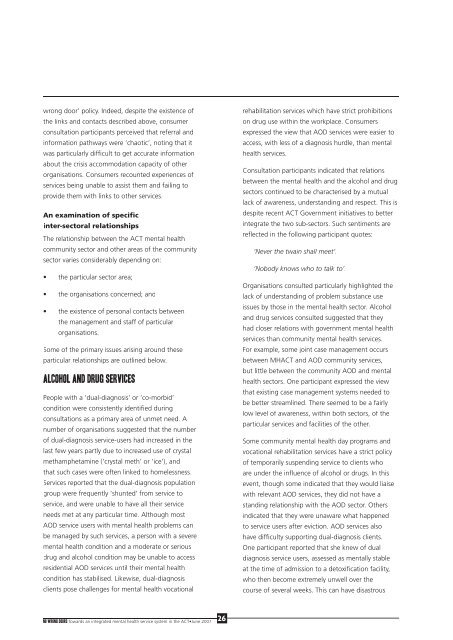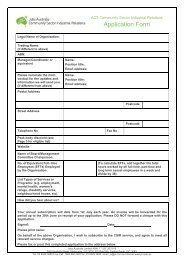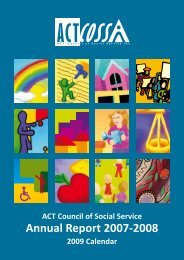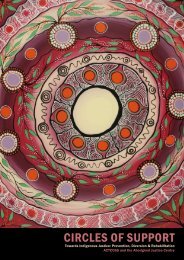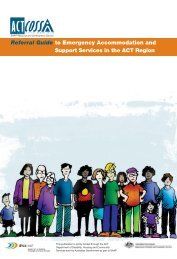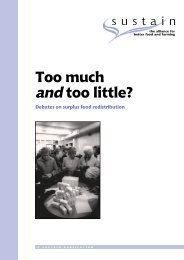actcoss text final.indd - ACT Council of Social Service
actcoss text final.indd - ACT Council of Social Service
actcoss text final.indd - ACT Council of Social Service
Create successful ePaper yourself
Turn your PDF publications into a flip-book with our unique Google optimized e-Paper software.
wrong door’ policy. Indeed, despite the existence <strong>of</strong><br />
the links and contacts described above, consumer<br />
consultation participants perceived that referral and<br />
information pathways were ‘chaotic’, noting that it<br />
was particularly difficult to get accurate information<br />
about the crisis accommodation capacity <strong>of</strong> other<br />
organisations. Consumers recounted experiences <strong>of</strong><br />
services being unable to assist them and failing to<br />
provide them with links to other services.<br />
An examination <strong>of</strong> specific<br />
inter-sectoral relationships<br />
The relationship between the <strong>ACT</strong> mental health<br />
community sector and other areas <strong>of</strong> the community<br />
sector varies considerably depending on:<br />
• the particular sector area;<br />
• the organisations concerned; and<br />
• the existence <strong>of</strong> personal contacts between<br />
the management and staff <strong>of</strong> particular<br />
organisations.<br />
Some <strong>of</strong> the primary issues arising around these<br />
particular relationships are outlined below.<br />
ALCOHOL AND DRUG SERVICES<br />
People with a ‘dual-diagnosis’ or ‘co-morbid’<br />
condition were consistently identified during<br />
consultations as a primary area <strong>of</strong> unmet need. A<br />
number <strong>of</strong> organisations suggested that the number<br />
<strong>of</strong> dual-diagnosis service-users had increased in the<br />
last few years partly due to increased use <strong>of</strong> crystal<br />
methamphetamine (‘crystal meth’ or ‘ice’), and<br />
that such cases were <strong>of</strong>ten linked to homelessness.<br />
<strong>Service</strong>s reported that the dual-diagnosis population<br />
group were frequently ‘shunted’ from service to<br />
service, and were unable to have all their service<br />
needs met at any particular time. Although most<br />
AOD service users with mental health problems can<br />
be managed by such services, a person with a severe<br />
mental health condition and a moderate or serious<br />
drug and alcohol condition may be unable to access<br />
residential AOD services until their mental health<br />
condition has stabilised. Likewise, dual-diagnosis<br />
clients pose challenges for mental health vocational<br />
rehabilitation services which have strict prohibitions<br />
on drug use within the workplace. Consumers<br />
expressed the view that AOD services were easier to<br />
access, with less <strong>of</strong> a diagnosis hurdle, than mental<br />
health services.<br />
Consultation participants indicated that relations<br />
between the mental health and the alcohol and drug<br />
sectors continued to be characterised by a mutual<br />
lack <strong>of</strong> awareness, understanding and respect. This is<br />
despite recent <strong>ACT</strong> Government initiatives to better<br />
integrate the two sub-sectors. Such sentiments are<br />
reflected in the following participant quotes:<br />
‘Never the twain shall meet’.<br />
‘Nobody knows who to talk to’.<br />
Organisations consulted particularly highlighted the<br />
lack <strong>of</strong> understanding <strong>of</strong> problem substance use<br />
issues by those in the mental health sector. Alcohol<br />
and drug services consulted suggested that they<br />
had closer relations with government mental health<br />
services than community mental health services.<br />
For example, some joint case management occurs<br />
between MH<strong>ACT</strong> and AOD community services,<br />
but little between the community AOD and mental<br />
health sectors. One participant expressed the view<br />
that existing case management systems needed to<br />
be better streamlined. There seemed to be a fairly<br />
low level <strong>of</strong> awareness, within both sectors, <strong>of</strong> the<br />
particular services and facilities <strong>of</strong> the other.<br />
Some community mental health day programs and<br />
vocational rehabilitation services have a strict policy<br />
<strong>of</strong> temporarily suspending service to clients who<br />
are under the influence <strong>of</strong> alcohol or drugs. In this<br />
event, though some indicated that they would liaise<br />
with relevant AOD services, they did not have a<br />
standing relationship with the AOD sector. Others<br />
indicated that they were unaware what happened<br />
to service users after eviction. AOD services also<br />
have difficulty supporting dual-diagnosis clients.<br />
One participant reported that she knew <strong>of</strong> dual<br />
diagnosis service users, assessed as mentally stable<br />
at the time <strong>of</strong> admission to a detoxification facility,<br />
who then become extremely unwell over the<br />
course <strong>of</strong> several weeks. This can have disastrous<br />
NO WRONG DOORS Towards an integrated mental health service system in the <strong>ACT</strong>•June 2007<br />
26


